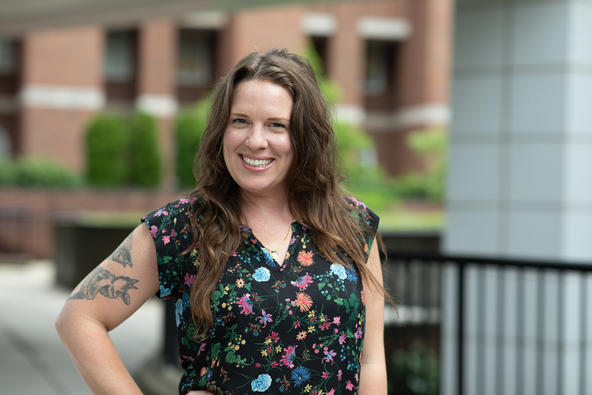Frazar Receives the Karen Wetterhahn Memorial Award for Scientific Excellence

Molly Frazar is the 24th recipient of the Karen Wetterhahn Memorial Award, which recognizes one outstanding graduate student or postdoctoral researcher who exemplifies qualities of scientific excellence, was presented last month at the National Institute of Environmental Health Sciences (NIEHS) Superfund Research Program (SRP) Annual Meeting.
Frazar, a University of Kentucky chemical and materials engineering doctoral candidate under the mentorship of J. Zach Hilt, Ph.D., at the UK Superfund Research Center (UKSRC), was recognized for her research to develop inexpensive and reusable sorbent materials that can selectively bind and capture per- and polyfluoroalkyl substances (PFAS).
"Lack of access to safe, clean drinking water is a constant threat that must be addressed through cost-effective and sustainable remediation technologies," said Frazar. "Through my research, I hope to facilitate the development of reusable technologies that can remove contaminants, such as PFAS, from water before human exposure occurs."
Traditional remediation technologies can be very costly and difficult to generate, so Frazar is studying how these sorbents can be recycled using low-energy and magnetic fields. "By making these materials easily recyclable, I hope to make them accessible or useful for other superfund sites or communities at risk of PFAS exposure through drinking water," she said.
In collaboration with another UK SRP Center trainee and Kentucky state agencies, Frazar initiated a pilot project to sample drinking water, wastewater, surface water and well water in a community where PFAS were detected above the health advisory guidelines. The team is taking the samples back to the lab to determine which sorbent materials can best remove PFAS and other contaminants.
"Molly is a leader among her peers." said Hilt, who is the Gill Eminent Professor of Chemical Engineering. "Her outstanding character, academic performance and seriousness of purpose are clear and allow her to enthusiastically and fearlessly move research from the lab and into the real world."
Last year, Frazar also received a K.C. Donnelly Externship Award to work with researchers at the U.S. Environmental Protection Agency (EPA) to gain a deeper understanding of how to best apply environmental research to support legislative decision-making related to risk assessment.
"Molly's energy is contagious. She is a true leader that has kept many of our trainees motivated to move persistently forward during difficult times," Kelly Pennell, director of the Superfund Research Center, said.
Outside of the lab, Frazar is actively involved in outreach for young girls and women to encourage interest in science-related careers. For example, she organized booths for the UK SRP Center at Expanding Your Horizons Opportunity Fairs.
"Just like Dr. Wetterhahn, I feel very passionate about increasing the interest and involvement of women in science," Frazar said. "If these young women can see me, confident in my role as a chemical engineer Ph.D. candidate, they will realize how attainable these types of fields are for them as well."
Frazar also acts as a mentor for UK undergraduates who aspire to gain research experience in a lab setting. Her mentorship work led her to receive the Tau Beta Pi Most Outstanding Graduate Student award, for which she was nominated and voted by her undergraduate research mentees.
Frazar's future professional plans include using her strong scientific background to successfully inform policies to help mitigate environmental pollution and its subsequent harmful effects, especially for the most vulnerable communities. She also hopes to continue helping form the next generation of researchers who can stand up to the environmental challenges faced by communities.
"Molly's approach to life, which is to live her passion, bring it to the lab and share it with the people she encounters, truly exemplifies Dr. Wetterhahn's legacy," Pennell said.
Credits
Text: Lindsey Piercy (Public Relations & Strategic Communication)
Photo: Eric Sanders (College of Engineering)

